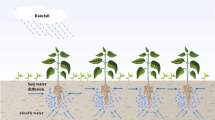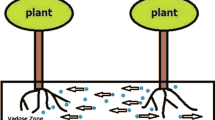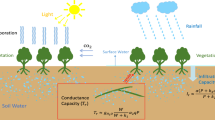Abstract
In this paper, we analyze how vegetation patterns occur in arid and semi-arid ecosystems with different types of grazing, using both modelling approaches and mathematical analysis. The concepts of Tipping point and Turing point are helpful for us to understand the desertification that catastrophic and critical transitions may have on ecosystems. In the mathematical analysis, we extrapolated our analysis to local stability and Turing instability of local and nonlocal models. We found that the uniform vegetation state changes to vegetation pattern state or bare soil state, which means that there is overgrazing in this ecosystem. Therefore, we propose that vegetation patterns may be a warning signal for the onset of desertification. Some notes on numerical simulation are given, based on different diffusion coefficients, infiltration parameters and grazing rate. Numerical simulation not only verifies the validity of the theoretical results, but also obtains some results which can not be obtained in mathematical analysis.















Similar content being viewed by others
Data availability
Some or all data, models, or code generated or used during the study are available from the corresponding author by request
References
Scanlon, T.M., Caylor, K.K., Levin, S.A.: Positive feedbacks promote power-law clustering of Kalahari vegetation. Nature 449(7159), 209–212 (2007)
Kefi, S., Rietkerk, M., Alados, C.L.: Spatial vegetation patterns and imminent desertification in Mediterranean arid ecosystems. Nature 449(7159), 213–217 (2007)
Rietkerk, M., Bastiaansen, R., Banerjee, S.: Evasion of tipping in complex systems through spatial pattern formation. Science 374(6564), eabj0359 (2021)
Klausmeier, C.A.: Regular and irregular patterns in semiarid vegetation. Science 284, 1826–1828 (1999)
Hillerislambers, R., Rietkerk, M., Bosch, F.V.D., Prins, H.H.T., Kroon, A.H.: Vegetation pattern formation in semi-arid grazing systems. Ecology 82(1), 50–61 (2001)
Rietkerk, M., Boerlijst, M.C., Langevelde, F.V., et al.: Self-organization of vegetation in arid ecosystems. Am. Nat. 160(4), 524–530 (2002)
Scheffer, M., Carpenter, S., Foley, J.A., et al.: Catastrophic shifts in ecosystems. Nature 413, 591–596 (2001)
Rietkerk, M., Dekker, S.C., Ruiter, P.C., Koppel, J.V.: Self-organized patchiness and catastrophic shifts in ecosystems. Science 305, 1926–1929 (2004)
Scheffer, M., Bascompte, J., Brock, W.A.: Early-warning signals for critical transitions. Nature 461(7260), 53–59 (2009)
Gilad, E., Hardenberg, J.V., Provenzale, A.: A mathematical model of plants as ecosystem engineers. J. Theor. Biol. 244(4), 680–691 (2007)
Paine, C.E.T., Marthews, T.R., Vogt, D.R.: How to fit nonlinear plant growth models and calculate growth rates: an update for ecologists. Methods Ecol. Evol. 3(2), 245–256 (2012)
Kefi, S., Rietkerk, M., Katul, G.: Vegetation pattern shift as a result of rising atmospheric CO\(_2\) in arid ecosystems. Theor. Popul. Biol. 74(4), 332–344 (2008)
Yin, H., Chen, X., Wang, L.: On a cross-diffusion system modeling vegetation spots and strips in a semi-arid or arid landscape. Nonlinear Anal. 159, 482–491 (2017)
Siero, E.: Nonlocal grazing in patterned ecosystems. J. Theor. Biol. 436(7), 64–71 (2018)
Maimaiti, Y., Yang, W.B., Wu, J.H.: Spatiotemporal dynamic analysis of an extended water-plant model with power exponent plant growth and nonlocal plant loss. Commun. Nonlinear Sci. Numer. Simul. 103, 105985 (2021)
Maimaiti, Y., Yang, W.B., Wu, J.H.: Turing instability and coexistence in an extended Klausmeier model with nonlocal grazing. Nonlinear Anal. Real World Appl. 64, 103443 (2022)
Shnerb, N.M., Sarah, P., Lavee, N.M., Solomon, S.: Reactive glass and vegetation patterns. Phys. Rev. Lett. 90, 038101 (2003)
Franklin, O., Harrison, S.P., Dewar, R., et al.: Organizing principles for vegetation dynamics. Nat. Plants 6(5), 444–453 (2020)
Kefi, S., Rietkerk, M., Katul, G.: Vegetation pattern shift as a result of rising atmospheric CO\(_2\) in arid ecosystems. Theor. Popul. Biol. 74(4), 332–344 (2008)
Ursino, N.: Modeling banded vegetation patterns in semiarid regions: interdependence between biomass growth rate and relevant hydrological processes. Water Resour. Res. 43, 1–9 (2007)
Pueyo, Y., Kefi, S., Alados, C.L., Rietkerk, M.: Dispersal strategies and spatial organization of vegetation in arid ecosystems. Oikos 117(10), 1522–1532 (2008)
Sherratt, J.A.: Pattern solutions of the Klausmeier model for banded vegetation in semi-arid environments I. Nonlinearity 23(10), 2657 (2010)
Sherratt, J.A.: Pattern solutions of the Klausmeier model for banded vegetation in semiarid environments IV: slowly moving patterns and their stability. SIAM J. Appl. Math. 73(1), 330–350 (2013)
Carter, P., Doelman, A.: Traveling stripes in the Klausmeier model of vegetation pattern formation. SIAM J. Appl. Math. 78(6), 3213–3237 (2018)
Hardenberg, J.V., Meron, E., Shachak, M., Zarmi, Y.: Diversity of vegetation patterns and desertification. Phys. Rev. Lett. 87(19), 549–553 (2001)
Sherratt, J.A., Synodinos, A.D.: Vegetation patterns and desertification waves in semi-arid environments: mathematical models based on local facilitation in plants. Discrete Contin. Dyn. Syst. Ser. B 17(8), 2815–2827 (2012)
Djilali, S., Bentout, S., Ghanbari, B.: Spatial patterns in a vegetation model with internal competition and feedback regulation. Eur. Phys. J. Plus 136(2), 1–24 (2021)
Zhang, F.F., Zhang, H.Y., Evans, M.R., et al.: Vegetation patterns generated by a wind driven sand-vegetation system in arid and semi-arid areas. Ecol. Complex. 31, 21–33 (2017)
Zhang, F.F., Zhang, H.Y., Huang, T.S., et al.: Coupled effects of Turing and Neimark–Sacker bifurcations on vegetation pattern self-organization in a discrete vegetation-sand model. Entropy 19(9), 478 (2017)
Zhang, F.F., Li, Y.X., Zhao, Y.L.: Vegetation pattern formation and transition caused by cross-diffusion in a modified vegetation-sand model. Int. J. Bifurcat. Chaos 32(05), 2250069 (2022)
Liu, Q.X., Jin, Z., Li, B.L.: Numerical investigation of spatial pattern in a vegetation model with feedback function. J. Theor. Biol. 254(2), 350–360 (2008)
Yin, M.H., Chen, X.F., Wang, L.H.: On a cross-diffusion system modeling vegetation spots and strips in a semi-arid or arid landscape. Nonlinear Anal. 159, 482–491 (2017)
Xiong, Z.X., Zhang, Q.M., Kang, T.: Bifurcation and stability analysis of a cross-diffusion vegetation–water model with mixed delays. Math. Methods Appl. Sci. 44(13), 9976–9986 (2021)
Manor, A., Shnerb, N.M.: Dynamical failure of Turing patterns. Europhys. Lett. 74, 837–843 (2006)
Wang, X.L., Wang, W.W., Zhang, G.H.: Vegetation pattern formation of a water-biomass model. Commun. Nonlinear Sci. Numer. Simul. 42, 571–584 (2017)
Lei, C.X., Zhang, G.H., Zhou, J.L.: Pattern formation of a biomass–water reaction–diffusion model. Appl. Math. Lett. 123, 107605 (2022)
Liu, S., Li, W., Qiao, W., et al.: Effect of natural conditions and mining activities on vegetation variations in arid and semiarid mining regions. Ecol. Indic. 103, 331–345 (2019)
Shi, J.P., Xie, Z.F., Little, K.: Cross-diffusion induced instability and stability in reaction–diffusion systems. J. Appl. Anal. Comput. 1(1), 95–119 (2011)
Yang, X.Y., Liu, T.Q., Zhang, J.J.: The mechanism of Turing pattern formation in a positive feedback system with cross diffusion. J. Stat. Mech. Theory Exp. 2014(3), P03005 (2014)
Guo, G.H., Zhao, S.H., Wang, J.J., et al.: Positive steady-state solutions for a water–vegetation model with the infiltration feedback effect. Discrete Contin. Dyn. Syst. Ser. B 29, 104008 (2023)
Marinov, K., Wang, T., Yang, Y.: On a vegetation pattern formation model governed by a nonlinear parabolic system. Nonlinear Anal. Real World Appl. 14(1), 507–525 (2013)
Vanag, V.K., Epstein, I.R.: Cross-diffusion and pattern formation in reaction–diffusion systems. Phys. Chem. Chem. Phys. 11(6), 897–912 (2009)
Jiang, W.H., Cao, X., Wang, C.C.: Turing instability and pattern formations for reaction–diffusion systems on 2D bounded domain. Discrete Contin. Dyn. Syst. Ser. B 27(2), 1163 (2022)
Liang, J., Liu, C., Sun, G.Q.: Nonlocal interactions between vegetation induce spatial patterning. Appl. Math. Comput. 428, 127061 (2022)
Ghorai, S., Poria, S.: Turing patterns induced by cross-diffusion in a predator-prey system in presence of habitat complexity. Chaos Solitons Fract. 91, 421–429 (2016)
Author information
Authors and Affiliations
Corresponding author
Ethics declarations
Competing Interest
The authors declare that they have no known competing financial interests or personal relationships that could have appeared to influence the work reported in this paper.
Additional information
Publisher's Note
Springer Nature remains neutral with regard to jurisdictional claims in published maps and institutional affiliations.
The work is sponsored by Natural Science Foundation of Xinjiang Uygur Autonomous Region (Nos. 2023D01C166), National Natural Science Foundation of China (Nos. 12301639, 12001425, 12171296), Talent Project of Tianchi Doctoral Program in Xinjiang Uygur Autonomous Region (No. 51052300524) and Natural Science Basic Research Program of Shaanxi (No. 2023-JC-YB-066).
Rights and permissions
Springer Nature or its licensor (e.g. a society or other partner) holds exclusive rights to this article under a publishing agreement with the author(s) or other rightsholder(s); author self-archiving of the accepted manuscript version of this article is solely governed by the terms of such publishing agreement and applicable law.
About this article
Cite this article
Maimaiti, Y., Yang, W. Spatial vegetation pattern formation and transition of an extended water–plant model with nonlocal or local grazing. Nonlinear Dyn 112, 5765–5791 (2024). https://doi.org/10.1007/s11071-024-09299-z
Received:
Accepted:
Published:
Issue Date:
DOI: https://doi.org/10.1007/s11071-024-09299-z




